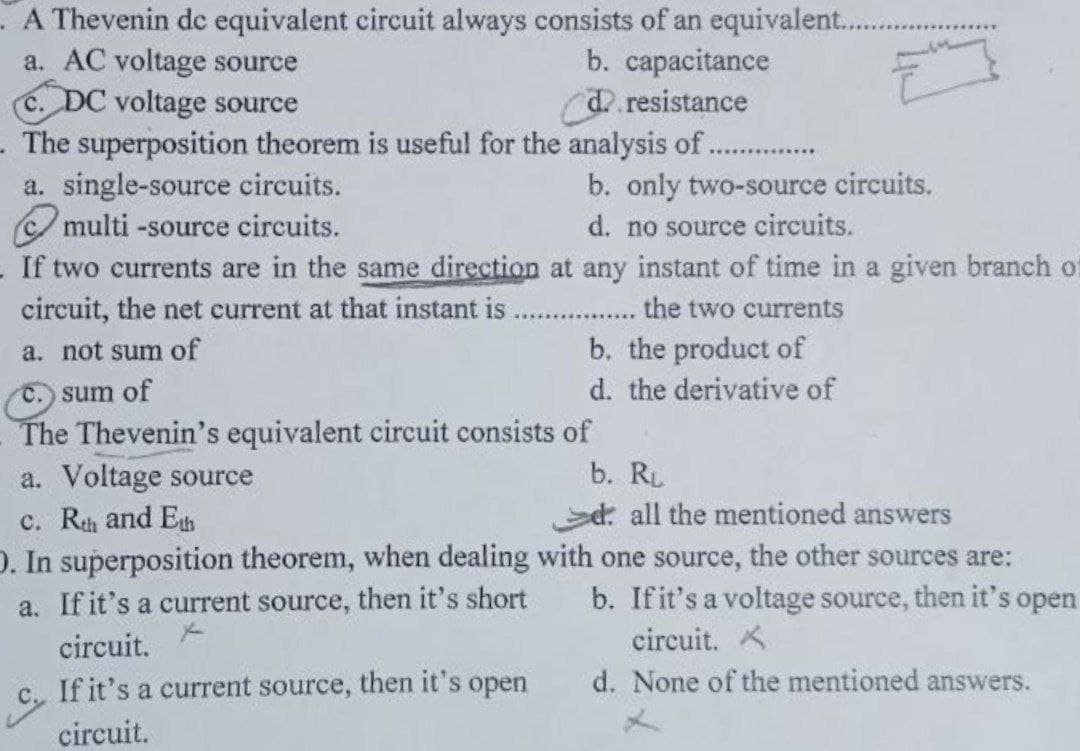A Thevenin de equivalent circuit always consists of an equivalent......... a. AC voltage source DC voltage source b. capacitance resistance E
A Thevenin de equivalent circuit always consists of an equivalent......... a. AC voltage source DC voltage source b. capacitance resistance E
Introductory Circuit Analysis (13th Edition)
13th Edition
ISBN:9780133923605
Author:Robert L. Boylestad
Publisher:Robert L. Boylestad
Chapter1: Introduction
Section: Chapter Questions
Problem 1P: Visit your local library (at school or home) and describe the extent to which it provides literature...
Related questions
Question

Transcribed Image Text:A Thevenin de equivalent circuit always consists of an equivalent.........
a. AC voltage source
b. capacitance
c. DC voltage source
Cd resistance
The superposition theorem is useful for the analysis of...........
a. single-source circuits.
b. only two-source circuits.
d. no source circuits.
multi-source circuits.
If two currents are in the same direction at any instant of time in a given branch of
circuit, the net current at that instant is
the two currents
********
a. not sum of
b. the product of
c.) sum of
d. the derivative of
The Thevenin's equivalent circuit consists of
a. Voltage source
b. Ru
c. Rth and Eth
d all the mentioned answers
D. In superposition theorem, when dealing with one source, the other sources are:
a. If it's a current source, then it's short
b. If it's a voltage source, then it's open
circuit.
circuit.
If it's a current source,
then it's open
d. None of the mentioned answers.
Cy
circuit.
Expert Solution
This question has been solved!
Explore an expertly crafted, step-by-step solution for a thorough understanding of key concepts.
Step by step
Solved in 2 steps with 2 images

Knowledge Booster
Learn more about
Need a deep-dive on the concept behind this application? Look no further. Learn more about this topic, electrical-engineering and related others by exploring similar questions and additional content below.Recommended textbooks for you

Introductory Circuit Analysis (13th Edition)
Electrical Engineering
ISBN:
9780133923605
Author:
Robert L. Boylestad
Publisher:
PEARSON

Delmar's Standard Textbook Of Electricity
Electrical Engineering
ISBN:
9781337900348
Author:
Stephen L. Herman
Publisher:
Cengage Learning

Programmable Logic Controllers
Electrical Engineering
ISBN:
9780073373843
Author:
Frank D. Petruzella
Publisher:
McGraw-Hill Education

Introductory Circuit Analysis (13th Edition)
Electrical Engineering
ISBN:
9780133923605
Author:
Robert L. Boylestad
Publisher:
PEARSON

Delmar's Standard Textbook Of Electricity
Electrical Engineering
ISBN:
9781337900348
Author:
Stephen L. Herman
Publisher:
Cengage Learning

Programmable Logic Controllers
Electrical Engineering
ISBN:
9780073373843
Author:
Frank D. Petruzella
Publisher:
McGraw-Hill Education

Fundamentals of Electric Circuits
Electrical Engineering
ISBN:
9780078028229
Author:
Charles K Alexander, Matthew Sadiku
Publisher:
McGraw-Hill Education

Electric Circuits. (11th Edition)
Electrical Engineering
ISBN:
9780134746968
Author:
James W. Nilsson, Susan Riedel
Publisher:
PEARSON

Engineering Electromagnetics
Electrical Engineering
ISBN:
9780078028151
Author:
Hayt, William H. (william Hart), Jr, BUCK, John A.
Publisher:
Mcgraw-hill Education,